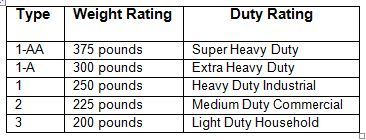Always choose the correct ladder for the job or task to be performed.
There are many types of ladders, ranging from simple wooden job-built ladders to specialty ladders used for specific jobs. Ladders may be made of timber, aluminum, or fiberglass. There are three main types of ladders used in the construction industry: 1) extension 2) step and 3) multi-purpose.

Keep the following in mind when choosing the right ladder for your job:
- For indoor use, stepladders or multi-purpose ladders are usually recommended.
- For outdoor work, taller stepladders, multi-purpose, or extension ladders are generally more appropriate.
- Do not use aluminum ladders when working around electricity. Chose a ladder made out of non-conductive material for electrical work, such as when working near overhead power lines.
- Make sure that the ladder is the proper length to do the job safely.
- Chose a ladder that is designed for how you intend to use it. For example, do not use step ladders in a folded and leaned position in place of a straight ladder.
- Chose a ladder that is capable of supporting your weight and the weight of any materials you will be using. See the chart below.

Ladders must be inspected before each use, and defective and or damaged ladders must not be used and must be removed from service until repaired.
Look for warning signs. Check all ladder components for signs of wear, corrosion and structural failure before each use. These inspections should include:
- Rungs - Check for broken split, cracked, corroded or missing rungs.
- Side Rails - Check for broken, split, cracked, corroded or missing side rails.
- Cracks - Check carefully for cracks; they are hard to see. Cracks weaken ladders.
- Excessive Bends - Check for rungs or side rails with excessive bends. Bent areas are greatly weakened and may fail during use.
- Hardware - Check for ladders with loose, corroded, or weakened fasteners and hardware.
- Feet - Check ladders for missing or damaged feet. Ladder feet may have both nonskid pads for use on hard surfaces (concrete), and metal feet for soft surfaces (dirt).
Coatings or Paint - Check for paint or other coating hiding defects. Wooden ladders shall not be painted or coated with any opaque covering, except for identification or warning labels which may be placed on one face only of a side rail. When other types of ladders are painted it is very hard for the user to observe defects/damage such as cracks or dents and painted areas must be inspected carefully for hidden damage.
Oil, Grease, and other Slipping Hazards - Inspect ladders for oil, grease, moisture or other slippery materials before use and clean as necessary. Capacity - Check the capacity label and make sure the ladder has sufficient capacity to hold you and everything you are wearing and/or carrying.
As simple as it may seem to use a ladder, many disabling injuries occur each year due to improper use of ladders. Knowing the “Do’s” and “Don’ts” can help you avoid becoming another victim of falling from a ladder.
Do… look overhead before placing a ladder, with special attention to power lines and other electrical hazards.
Don’t… assume the area above the ladder is clear of hazards.
Do… use ladders made of non-conductive material when working around power lines or other electrical hazards.
Don’t… use aluminum ladders when working around electricity.
Do… set up the ladder on the ground, floor, or other level, stable surface.
Don’t… place a ladder on slippery, cluttered, or unstable surfaces such as boxes, carts, tables, etc.
Do… take your time and climb one rung at a time while using the “3 Point Contact” rule.
Don’t… hurry up a ladder to complete a task.
Do… climb down and move the ladder to get proper access to the work area. Keep your belt buckle between the side rails.
Don’t… overreach beyond the side rails to conduct work.
Do… climb all ladders facing the rungs.
Don’t… turn your back to the ladder at any time.
Do… use a bucket or other means to lift objects to the work area.
Don’t… carry heavy objects or tools up the ladder.

